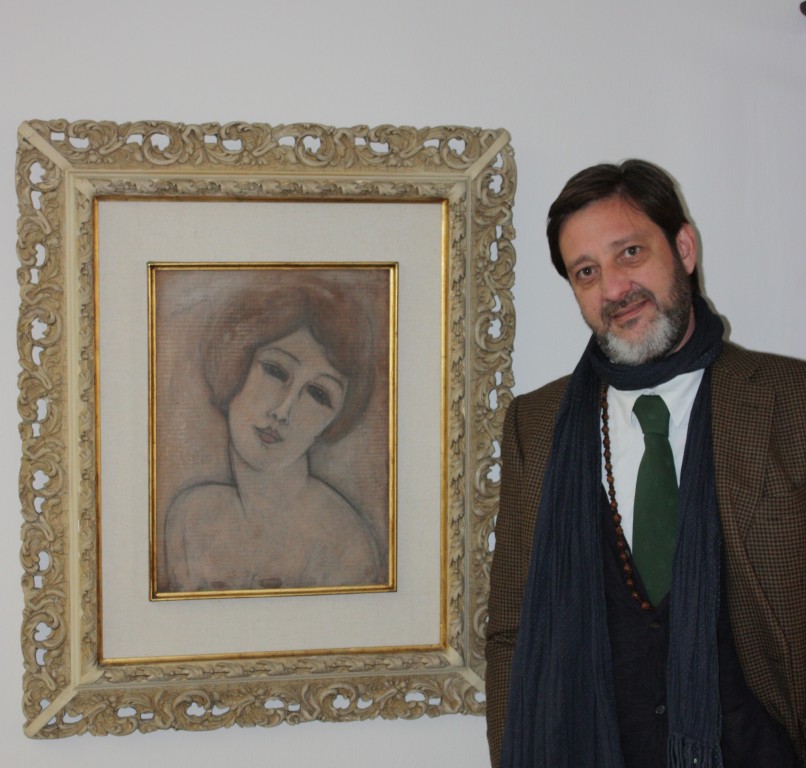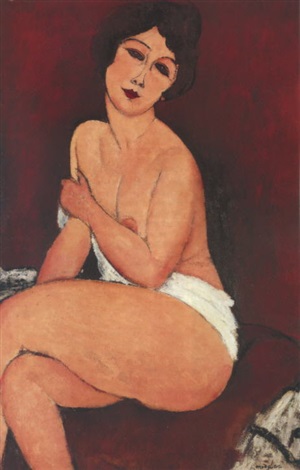Galleries
Is this Unknown Amedeo Modigliani Work Real?
Auction house says owner didn’t care for “commercial certifications.”

Auction house says owner didn’t care for “commercial certifications.”

Rozalia Jovanovic

Online auction house Gorgeov’s sent out an email this week announcing that it had “acquired an unknown work” by Amedeo Modigliani, the Italian artist known for his elongated portraits.
The work in question is a painting in “Pastel et crayon sur toile,” a study created in 1917 for one of Modigliani’s masterpieces, La Belle Romaine (1917), an oil painting of a nude woman against a wine-colored backdrop, which broke the artists record at auction when it sold at Sotheby’s in 2010 for $68.9 million.
While there is no definitive record of the artist’s work, there are five catalogues raisonnés that deal comprehensively with the artist’s paintings—by art critic Arthur Pfannstiel (1956), appraiser Ambrogio Ceroni (1965), Modigliani expert Joseph Lanthemann (1970), scholar Osvaldo Patani (1991–94), and Parisot. For the works on paper, Noel Alexandre’s The Unknown Modigliani: Drawings from the Collection of Paul Alexandre, 1993, a book by the son of Paul Alexandre (the artist’s first patron), is considered to be the most significant monograph on Modigliani drawings until 1913.
The press release of Gorgeov’s Auctions, which maintains its business in Andorra and Luxembourg, gives a wild story of the painting’s provenance beginning with the original owner of the work who was Emilio Gorgoll, a renowned painter and poster artist in Paris who knew Modigliani personally, and implicating the playwright Jean Cocteau. In the late 1960s the painting had been presented to Pfannstiel who analyzed the work and “certified the work as authentic.” The letter also says that Pfannstiel intended to include it in his upcoming catalogue raisonné, but he died before it was realized. But Pfannstiel wasn’t the only expert around at that time. Ceroni’s catalogue raisonné, published in 1965, is widely considered to be the most comprehensive and the most respected compendium of Modigliani’s works to this day.

Amedeo Modigliani, La Belle Romaine (1917)
“We find it impossible to get the work [certified] by someone consensual and recognized in the sector,” said Manuel Giraudier, an art adviser and the head of Gorgeov’s art department, when we reached him via email. “Our alternative was to objectively study the work, that is, historically.”
Though there’s a certificate in the documentation by Pfannstiel, the auction house says in its press release, “the new owner, in love with the painting, had the work during for more than 45 years presiding over your living room, not caring the ‘commercial certifications’ that in the business of art subsequently emerged,” in the 1980s and 90s. Was the Pfannstiel certificate not enough? Are they saying that you too should not care about “commercial certifications”?
Giraudier, who says the work will be auctioned in September, provided us with some 93 pages of documentation supporting the provenance of the work, including hand-written notes and newspaper articles, as well as a certificate written in French, apparently signed by Arthur Pfannstiel, which purports to authenticate a work entitled le Buste d’un Jeune Femme. To the casual observer, these documents are difficult to make heads-or-tails of.
According to Giraudier, Gorgeov’s auctions, which are not public and are only for registered users, has some built-in precautions for ensuring the works sold are authentic. Their criteria for selecting works, he says, are: 1) the works must not have been on the market for at least 15 years,” and have remained in the same collection until then, 2) they only accept “great Masterpieces of Impressionist, modern and contemporary art,” and 3) all the works are certified “by world renowned experts, the expert accepted routinely in the art market and also by the two major auction houses.”
It is true that the world of Modigliani authentication by expert is a thorny one. There are few experts out there, and of the experts that exist, their attempts at authentication are stymied by scandal and threats from disgruntled collectors.
Christian Parisot, an adviser whose role as Modigliani expert is contentious in the art community, and who touted his friendship with Modigliani’s late daughter Jeanne, was recently arrested after a two-year investigation that culminated in the removal of 22 purportedly false Modigliani works from a show he had organized in Palestrina, Italy. The investigation is still underway.
There’s also the scholar Marc Restellini. In 1997, the Wildenstein Institute announced that it was collaborating with Restellini on a catalogue raisonné of Modigliani paintings and one on works on paper. But the scholar dropped that project in 2001 after being overwhelmed by authentication requests by collectors and even receiving a death threat.
We reached out to one art dealer of Impressionist and 20th-century art, who wished to remain anonymous, who was given Gorgeov’s press release, which included the image, and had this to say: “From the press photo it doesn’t seem to me to be right.”
While others may need documentary proof, according to Giraudier, the current owners were well aware of the origins of this work and they’ve “personally enjoyed the work and never worried about the possibility of selling it.”
To those interested, caveat emptor. But ultimately, if, after purchasing the work, you don’t like it, you have another out. Per the “Our Auctions” section of Gorgeov’s website, in which commonly asked questions are answered, it states that if a buyer is interested in seeing the work she bought in person, after making a deposit into an escrow account, she can visit the work at a “dedicated facility in Luxembourg,” and if she doesn’t like it, after physical inspecting it, she “should not give us any explanation. Simply have to notify to the Bank and us your decision. The bank will fully refund your deposit.”